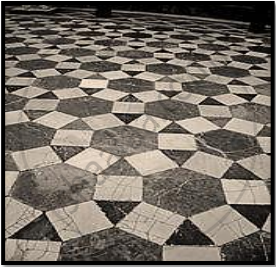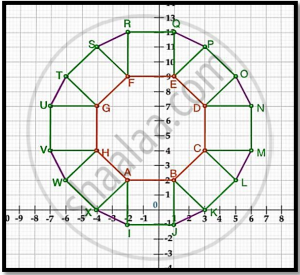Advertisements
Advertisements
प्रश्न
Show that the following points are the vertices of a rectangle
A (0,-4), B(6,2), C(3,5) and D(-3,-1)
उत्तर
The given points are A (0,-4), B(6,2), C(3,5) and D(-3,-1).
`AB = sqrt((6-0)^2 +{2-(-4)}^2) = sqrt((6)^2 +(6)^2) = sqrt(36+36) = sqrt(72) = 6 sqrt(2) units`
`BC = sqrt(( 3-6)^2 + (5-2)^2) = sqrt((-3)^2 +(3)^2) = sqrt(9+9) = sqrt(18) = 3 sqrt(2) units`
` CD = sqrt((-3-3)^2 +(-1-5)^2) = sqrt((-6)^2 +(-6)^2) = sqrt(36+36) = sqrt(72) = 6 sqrt(2) units`
` AD = sqrt((-3-0)^2 + { -1-(-4)}^2) = sqrt((-3)^2 +(3)^2) = sqrt(9+9) = sqrt(18) = 3 sqrt(2) units`
` Thus , AB =CD = sqrt(10) " units and " BC = AD = sqrt(5) units`
`Also , AC = sqrt((3-0)^2 +{ 5-(-4)}^2) = sqrt((3)^2 +(9)^2 )= sqrt(9+81) = sqrt(90) = 3 sqrt(10) units`
`BD = sqrt((-3-6)^2 +(-1-2)^2) = sqrt((-9)^2 +(-3)^2) = sqrt(81+9) = sqrt(90) = 3 sqrt(10) units`
Also, diagonal AC = diagonal BD
Hence, the given points from a rectangle
APPEARS IN
संबंधित प्रश्न
On which axis do the following points lie?
Q(0, -2)
Three consecutive vertices of a parallelogram are (-2,-1), (1, 0) and (4, 3). Find the fourth vertex.
The points (3, -4) and (-6, 2) are the extremities of a diagonal of a parallelogram. If the third vertex is (-1, -3). Find the coordinates of the fourth vertex.
Determine the ratio in which the straight line x - y - 2 = 0 divides the line segment
joining (3, -1) and (8, 9).
Find the points on the x-axis, each of which is at a distance of 10 units from the point A(11, –8).
Show that the following points are the vertices of a square:
A (0,-2), B(3,1), C(0,4) and D(-3,1)
Show that the points A(6,1), B(8,2), C(9,4) and D(7,3) are the vertices of a rhombus. Find its area.
If the points P (a,-11) , Q (5,b) ,R (2,15) and S (1,1). are the vertices of a parallelogram PQRS, find the values of a and b.
Prove that the diagonals of a rectangle ABCD with vertices A(2,-1), B(5,-1) C(5,6) and D(2,6) are equal and bisect each other
Find the point on x-axis which is equidistant from points A(-1,0) and B(5,0)
Find the possible pairs of coordinates of the fourth vertex D of the parallelogram, if three of its vertices are A(5, 6), B(1, –2) and C(3, –2).
If the mid-point of the segment joining A (x, y + 1) and B (x + 1, y + 2) is C \[\left( \frac{3}{2}, \frac{5}{2} \right)\] , find x, y.
If P (2, 6) is the mid-point of the line segment joining A(6, 5) and B(4, y), find y.
If (−1, 2), (2, −1) and (3, 1) are any three vertices of a parallelogram, then
The line segment joining points (−3, −4), and (1, −2) is divided by y-axis in the ratio.
f the coordinates of one end of a diameter of a circle are (2, 3) and the coordinates of its centre are (−2, 5), then the coordinates of the other end of the diameter are
Students of a school are standing in rows and columns in their playground for a drill practice. A, B, C and D are the positions of four students as shown in figure. Is it possible to place Jaspal in the drill in such a way that he is equidistant from each of the four students A, B, C and D? If so, what should be his position?
If the points P(1, 2), Q(0, 0) and R(x, y) are collinear, then find the relation between x and y.
Given points are P(1, 2), Q(0, 0) and R(x, y).
The given points are collinear, so the area of the triangle formed by them is `square`.
∴ `1/2 |x_1(y_2 - y_3) + x_2(y_3 - y_1) + x_3(y_1 - y_2)| = square`
`1/2 |1(square) + 0(square) + x(square)| = square`
`square + square + square` = 0
`square + square` = 0
`square = square`
Hence, the relation between x and y is `square`.
A tiling or tessellation of a flat surface is the covering of a plane using one or more geometric shapes, called tiles, with no overlaps and no gaps. Historically, tessellations were used in ancient Rome and in Islamic art. You may find tessellation patterns on floors, walls, paintings etc. Shown below is a tiled floor in the archaeological Museum of Seville, made using squares, triangles and hexagons.

A craftsman thought of making a floor pattern after being inspired by the above design. To ensure accuracy in his work, he made the pattern on the Cartesian plane. He used regular octagons, squares and triangles for his floor tessellation pattern

Use the above figure to answer the questions that follow:
- What is the length of the line segment joining points B and F?
- The centre ‘Z’ of the figure will be the point of intersection of the diagonals of quadrilateral WXOP. Then what are the coordinates of Z?
- What are the coordinates of the point on y-axis equidistant from A and G?
OR
What is the area of Trapezium AFGH?
